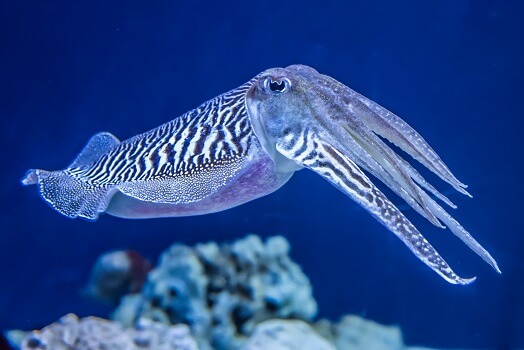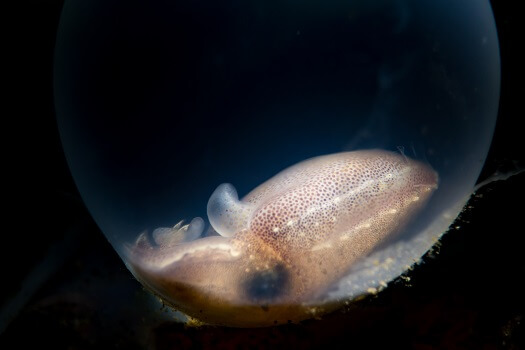
Despite their name, cuttlefish are not fish but are marine mollusks that are closely related to octopuses and squid. These fascinating animals are small-medium sized cephalopods that are found in many of the world’s oceans. Cuttlefish have elongated bodies and a large head that has big eyes and a beak-like mouth. Like octopuses, they have eight arms as well as two additional longer tentacles that they used to capture prey. These tentacles can be withdrawn into two pouches. The arms and tentacles both have suction disks that can be used to help them move, as well as to immobilize prey. A single fin – which runs around their body like a skirt – is very muscular and can move the cuttlefish in any direction. These mollusks are found across the globe, from warm, tropical seas to the cold, deep depths of the ocean. Specifically, cuttlefish are found in coastal regions in East and South Asia, in parts of Western Europe, and the Mediterranean, as well as all coasts of Africa and Australia. They have never been found in the Americas. There are 120 species in total that range in size, from the very small flamboyant cuttlefish (Metasepia pfefferi) – which reaches 3.1 inches (8 cm) in length – to the largest species, the Australian giant cuttlefish (Sepia apama). This large cuttlefish can reach 20 inches (50cm) in length, not including its tentacles, and can be more than 23 lbs (10.5 kg) in weight. Cuttlefish are carnivores, preying mostly on shrimp and crabs but they also eat a lot of different fish species. These mollusks are highly intelligent and have one of the largest brain-to-body size ratios of all invertebrates. This means that they can learn and remember. They also have extremely good eyesight, despite being color blind, and can change their shape, color, and movements rapidly to communicate and to camouflage. The most common predators of cuttlefish are sharks, larger fish, and even other cuttlefish. Humans also hunt them for food. Like octopuses, cuttlefish have ink that they can use to escape from predators. This ink is stored in an ink sac until its needed, at which point cuttlefish can release it into the water to create a diversion so they can escape. This diversion takes one of two forms; in the first, the ink is released and forms a screen behind which the cuttlefish can make a quick escape. In the second, the ink is released in bubbles that are surrounded by mucus and appear to be the same size and shape as the cuttlefish, distracting the predator from the actual cuttlefish which enables it to escape. Common cuttlefish or European common cuttlefish (Sepia Officinalis) is one of the best-known cuttlefish species. They are a large species that migrate between inshore areas, where they breed in the spring and summer months, and deeper depths which they migrate to during the winter. Flamboyant cuttlefish (Metasepia pfefferi) are found in the Indo-Pacific waters off northern Australia as well as near numerous islands in the Philippines, Indonesia, and Malaysia. This cuttlefish has an amazing defense mechanism – its flesh contains a unique toxin which makes it dangerous to eat. Pacific bobtail squid (Sepioloidea Pacifica) is a species of cuttlefish that is native to the southern Pacific Ocean. It is found off of the east and west coasts of New Zealand. Koch’s bottletail squid or the tropical bottletail squid (Sepiadarium kochi) is a species of cuttlefish found in the Indo-West Pacific from India to Japan. It is also found in the Indo-Malayan region. This edible cuttlefish is small in size, with a maximum mantle length of 3 cm. Cuttlefish are weird and wonderful animals that are truly interesting to observe. From having three hearts to being able to rapidly change color, these creatures are a great example of some fascinating biological concepts. Let’s take a closer look! Like octopuses, cuttlefish have three hearts. One heart pumps oxygenated blood to the entire body, whereas the other two are used to pump blood to the cuttlefishes large gills – one for each set. Their blood is also blue-green due to a copper-containing protein it has in its blood, called hemocyanin. Haemocyanin is used to carry oxygen like the red, iron-containing protein called hemoglobin that mammals and many other animals have. Cuttlefish are often referred to as the ‘chameleons of the sea’ due to their color-changing ability. Some species use disruptive patterning which breaks up their outline, while other species change color to blend in with their surroundings. These mollusks have specialized skin cells called chromatophores, that can be expanded and contracted to produce changes in skin color. The cells can be used independently or together to produce a variety of colors and patterns. They can change their appearance in a few seconds and can even use camouflage in the dark! Cuttlefish don’t only use their color-changing abilities to camouflage themselves, they also use these abilities to attract mates during the breeding season. The males will attract females by changing color, as well as using these color-changing abilities to ward off other males. Some male cuttlefish use their color-changing abilities to trick other males into thinking that they are female so that they can sneak in and mate with their female without getting caught. These cuttlefish are known as ‘sneaker-males’. Cuttlefish have a long bone within their body, called a cuttlebone, that they use to regulate their buoyancy. The cuttlebone is not actually a bone but an internal shell that is made from aragonite – a form of calcium carbonate that forms a lattice-like structure. Several chambers within this shell can be filled with gas, or water, depending on where they are in the water column. For example, if the cuttlefish wants to sink it will add more water then gas to the chambers in the cuttlebone. In contrast, if the cuttlefish want to rise it adds more gas than water. Cuttlebones are sold in pet stores as a supplement for some animals, including birds as it contains a large amount of calcium. Cuttlefish have uniquely-shaped, weird, and wonderful eyes that enable them to spot suitable prey and begin hunting as soon as they hatch. These mollusks have large eyes that are dark red in color and have a distinctive w-shaped pupil. Cuttlefish have extremely well-developed eyes from birth. The design of their eyes helps them to see through the scattered light found in the ocean so that they can hunt out prey. Cuttlefish are color blind but they can see contrasts in light caused by polarization. Despite being color blind, these mollusks have fantastic eyesight and can rapidly move their entire lens to help them to focus on objects. They use this ability to focus rapidly to help them to differentiate between colors. They have no blind spot because the optic nerve is behind the retina. Cuttlefish are colorblind, but they can see contrasts in light caused by polarization. To focus on things, these mollusks will shift the entire lens in its eye to get an accurate image. Even before it is born, the cuttlefish can use its eyes to spot suitable prey to begin hunting when it hatches.
Kingdom
Animalia
Phylum
Mollusca
Class
Cephalopoda
Order
Sepiida
Family
6
Genus
Multiple
Species
Over 120
Niche
Carnivorous
Length
5.9in – 20in (15 – 50cm)
Weight
6.6lbs – 23lbs (3 – 10.5 kg)
Lifespan
1 – 2 years
Social Structure
Solitary
Status
Least Concern
Natural Habitat
Ocean
Average Litter Size
200
Main food item
Crab, Shrimp, Fish
Main threats
Overexploitation in some areas
The Basics

Notable Cuttlefish Species

Fun Facts about the Cuttlefish!
Cuttlefish Have Three Hearts
Chameleons of the Sea
Cuttlebone

W Shaped Pupil
